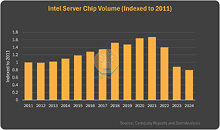- Joined
- Aug 19, 2017
- Messages
- 3,018 (1.07/day)
Intel's data center business has experienced a lot of decline in recent years. Once the go-to choice for data center buildout, nowadays, Xeon processors have reached a 13-year low. According to SemiAnalysis analyst Sravan Kundojjala on X, the once mighty has fallen to a 13-year low number, less than 50% of its CPU sales in the peak observed in 2021. In a chart that is indexed to 2011 CPU volume, the analysis gathered from server volume and 10K fillings shows the decline that Intel has experienced in recent years. Following the 2021 peak, the volume of shipped CPUs has remained in free fall, reaching less than 50% of its once-dominant position. The main cause for this volume contraction is attributed to Intel's competitors gaining massive traction. AMD, with its EPYC CPUs, has been Intel's primary competitor, pushing the boundaries on CPU core count per socket and performance per watt, all at an attractive price point.
During a recent earnings call, Intel's interim c-CEO leadership admitted that Intel is still behind the competition with regard to performance, even with Granite Rapids and Clearwater Forest, which promised to be their advantage in the data center. "So I think it would not be unfathomable that I would put a data center product outside if that meant that I hit the right product, the right market window as well as the right performance for my customers," said Intel co-CEO Michelle Johnston Holthaus, adding that "Intel Foundry will need to earn my business every day, just as I need to earn the business of my customers." This confirms that the company is now dedicated to restoring its product leadership, even if its internal foundry is not doing okay. It will take some time before Intel CPU volume shipments recover, and with AMD executing well in data center, it is becoming a highly intense battle.

View at TechPowerUp Main Site | Source
During a recent earnings call, Intel's interim c-CEO leadership admitted that Intel is still behind the competition with regard to performance, even with Granite Rapids and Clearwater Forest, which promised to be their advantage in the data center. "So I think it would not be unfathomable that I would put a data center product outside if that meant that I hit the right product, the right market window as well as the right performance for my customers," said Intel co-CEO Michelle Johnston Holthaus, adding that "Intel Foundry will need to earn my business every day, just as I need to earn the business of my customers." This confirms that the company is now dedicated to restoring its product leadership, even if its internal foundry is not doing okay. It will take some time before Intel CPU volume shipments recover, and with AMD executing well in data center, it is becoming a highly intense battle.

View at TechPowerUp Main Site | Source






